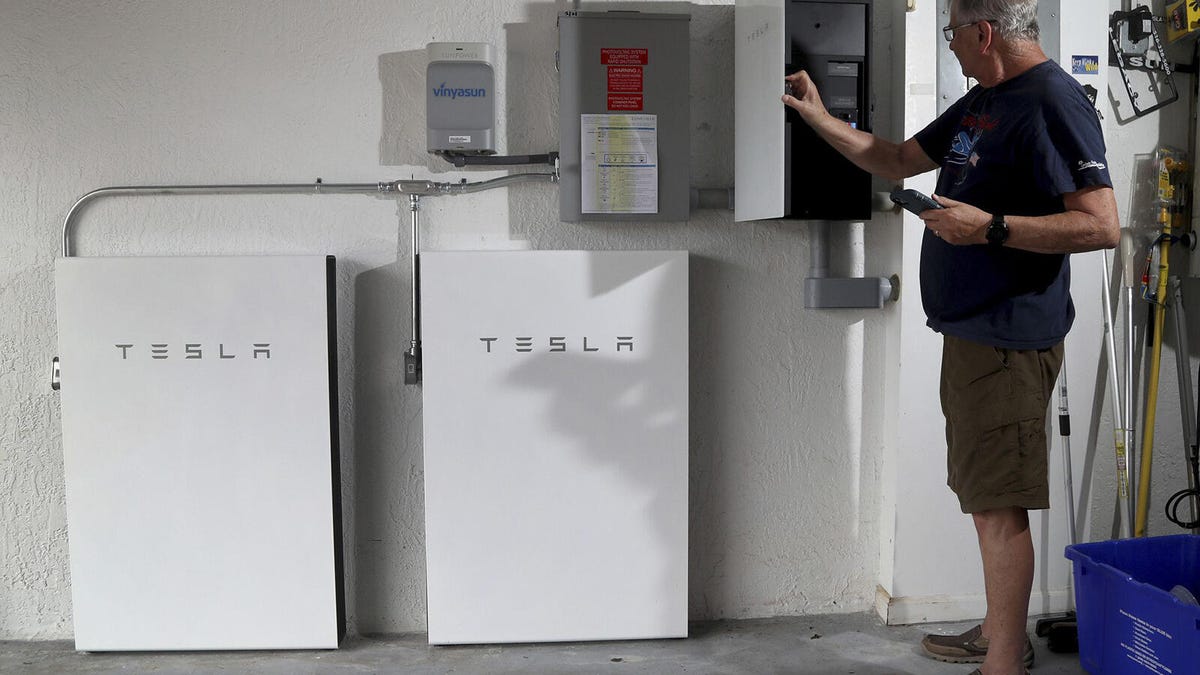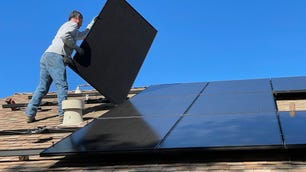What Size Home Battery Do I Need?

The right battery capacity (also referred to as sizing) is of the utmost importance when finding a home battery to meet your household’s energy needs. But how do you know what size is right for your home? That’ll depend on your energy consumption and how you plan to use your battery.
“You want to have a battery that can provide the length of backup that you desire,” Josh Lutton, president of Certasun, a solar company serving Chicago and Milwaukee, told CNET.
Here’s what you need to know about your home battery’s capacity.
Can solar panels save you money?
Interested in understanding the impact solar can have on your home? Enter some basic information below, and we’ll instantly provide a free estimate of your energy savings.
What is a home battery?
A home battery isn’t like a small AAA battery that you might use to power your TV remote — it’s much bigger. Home batteries are essentially giant batteries that store large amounts of energy, capable of powering your home during an outage. The battery integrates with your home’s electrical system and can be charged with power from the grid or solar panels.
If you have solar panels, you’ll be able to stash away any excess energy your solar panels produce into the battery to be used later. You might use this stored energy to power your home with solar at night or to offset your energy use.
Certain utilities charge different rates for electricity used at specific times of the day, usually during hours when the demand for electricity is highest. These are called time of use rates. To avoid paying high electricity rates, you can use the stored energy from your battery to power your home during hours of high electricity demand. You can recharge your battery during parts of the day when energy rates are lower.
What is battery capacity?
Batteries are “sized” based on their energy storage capacity. Battery capacity is the amount of energy your battery can put away into storage to be used for later. The larger the capacity, the more energy you can stash away. It’s measured in kilowatt-hours (kWh), which is a measurement of energy used over a period of time. We’ll dive more into the specifics of that below.
When looking at a specific battery, its capacity is likely the first thing you’ll see. Some manufacturers even stick a battery’s capacity right in the name of the product. LG Energy Solution tends to include its capacity somewhere in the name. The LGES 10H Prime is a 10-kWh battery and the LGES 16H Prime is a 16-kWh battery.
Some batteries might come with two different capacity ratings that you should be aware of: usable capacity and maximum capacity. A battery’s maximum capacity is the total amount of energy it can store. Usable capacity is the amount of energy you’ll actually be able to use or allowed access to from the maximum amount.
How to choose the best home battery backup for your needs
Home batteries aren’t a one-size-fits-all solution. Every home is different and every household’s energy needs are different. You need to size your battery based on what you plan to use it for (backup or energy offset) and how much power you use. If you get a battery that stores way more energy than you’re going to consume, it’s likely too big. Batteries with more capacity also tend to be more expensive. However, if your battery is too small, it might not be able to provide enough power to get you through an outage.
It all depends on how much energy the consumer is using, Lutton said. And that varies all the time. Your energy usage is measured in kilowatt-hours (kWh). To be specific, it’s the amount of kilowatts (kW) that are consumed in an hour. One kilowatt is equal to 1,000 watts. So for example, if you turned on an appliance for an hour and it used 1,500 watts, then that would mean the appliance consumed 1.5 kWh of energy.
Your installer will perform an energy audit and site assessment to find your average household energy consumption. You can get an understanding of this on your own too by looking at a few months’ worth of your most recent electric bills. Your electricity usage is most likely highest during months when you’re constantly heating and cooling your home, so make sure to look at a few bills from winter and summer months.
It’s also worth considering buying a battery that can be upgraded in the future if your energy needs change. An installer will look at how much energy has been consumed over the course of a year, Lutton said. From there, they can start calculating what that energy use would look like on a typical day. He said the right size battery doesn’t depend on the size of the house — it depends on how much energy it uses.
Partial home backup vs. whole home backup
One of the most important things to take into consideration when choosing your battery is what type of backup system you want. This is a determining factor in how much of your home will be powered by the battery during an outage. You’ll either have a partial home or whole home battery backup system.
Your installer might ask what your backup objectives are, Lutton said. Installers need to know your energy goals and consumption so they can design a system that meets your expectations.
Whole home backup solutions are designed to power your entire home in the event of an outage. Because you’ll most likely need multiple batteries, this type of backup system can get very expensive and can be a bit unrealistic.
Most homes are wired for partial home backup. Instead of trying to power your entire house during an outage, you’ll pick a few essential loads for the battery to send power to. Think of essential loads as things that need to have power during an outage. Things like your fridge, internet, lights, TV and maybe an additional appliance or two could be considered essential loads. Carefully consider what you choose as your “essentials.”
Picking too many energy-hungry appliances will drain up your battery very quickly, and your battery might not be able to provide power to all those loads simultaneously in the first place. The chosen loads will be moved to a separate electrical panel (usually called the critical load panel) and are considered priority loads for the battery to power.
Battery performance
Aside from capacity, there are other performance-based specifications to take a look at when shopping for a battery backup.
- Round-trip efficiency: Round-trip efficiency is the percentage of energy that makes it into energy storage without getting lost, usually to heat. The higher the efficiency, the less energy is lost. Minimizing energy losses between charging cycles helps keep the battery working as well as it can. The usual round-trip efficiency rating of batteries on the market today is about 90%.
- Depth of discharge: This is how much energy you can drain (discharge) from the battery relative to its maximum capacity. It signifies how much energy (a percentage) you can use from the battery without fearing damage. The closer to 100%, the better. However, you should avoid completely draining your battery to zero, as this can help shorten its lifespan. Not all manufacturers reveal this figure.
- Power output: A battery’s power output tells you how much power it’s able to handle at a given moment. You’ll typically see two different ratings: peak and continuous. A battery’s peak rating is the amount of power it’s able to output all at once without damaging anything. Think of it as a large burst of energy that’s needed to start large loads, like your air conditioner. Continuous power is the amount of power the battery is able to output at all times.
Do you have solar panels?
While you can have just a battery by itself, many people tend to pair batteries with solar panels. It’s a pairing that makes a lot of sense. Solar plus storage systems let you store any excess electricity produced by your solar panels in the battery. You can use that stored energy for backup during an outage, time of use offset or even use it to power your home with solar at night.
Since you’ll be able to produce your own energy with your solar panels, you won’t have to pull as much energy from the grid to recharge the battery. It’s a more self-sufficient system.
“The solar panels can recharge the battery even if the grid is down,” Lutton said. “It depends on how sunny it is and how big the battery is. In theory, you can design a system that will keep recharging forever so you never run out of power.”
However, these systems come at a cost. The cost of the solar panel system itself will cost you tens of thousands of dollars. Adding a battery could cost anywhere from $12,000 to $22,000, according to the US Department of Energy.
Frequently asked questions
How long will a 10-kWh battery power my house?
This depends on what appliances and electronics you’re trying to power and how long they will be in use. You’ll also need to factor in the length of the outage. The average American household uses around 30 kWh per day, so 10 kWh should meet many of your energy needs for a good portion of the day unless you are running large appliances.
What is the average size of a home battery?
Home battery storage capacities are pretty varied, but the average home battery capacity is likely going to be somewhere between 10 kWh and 15 kWh.
Source: CNET












